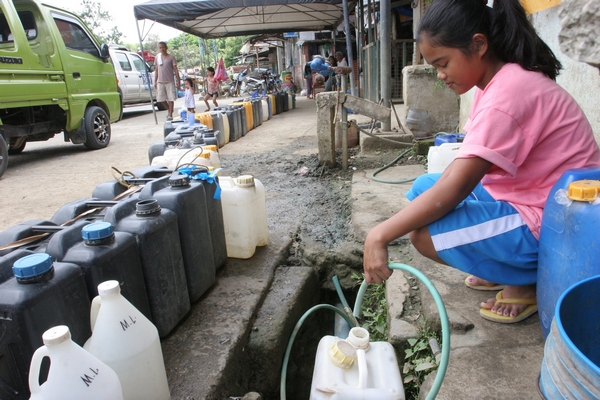
Barangay Sirao residents wait for the fire truck that would provide them free drinking water in this 2016 CDN file photo taken at the height of the El Niño phenomenon. Metro Cebu is expected to face shortage of potable water in seven years. CDN FILE PHOTO
Aside from the monstrous traffic, pollution, floods and an ever-rising crime rate, Metro Cebu will soon have to contend with another major problem — shortage of potable water.
And this bleak scenario could happen as early as seven years from now.
This was the projection of the Metropolitan Cebu Water District (MCWD) as it unveiled plans of reviving a proposal to construct three additional dams, the Mananga-Lusaran-Kotkot Dams that were shelved in 2016 for lack of funding.
But MCWD spokesperson Charmaine Rodriguez-Kara said the plan may soon be realized as they have resorted to bidding them out to the private sector. She said this is because of government lending banks did not grant them a guarantee for a loan, which could have helped them implement the projects on their own.
In 2016, the Japan International Cooperation Agency (JICA) estimated the construction of the three dams to reach P10.5 billion.
“We are already in talks with some companies. There’s four of them. Some of the companies that we’ve been coordinating are Ayala, the Manny V. Pangilinan group of companies. Our plan is to bid them out this year,” said Kara.
The MCWD’s proposal was also supported by Engr. Oscar Tabada, Visayas director of the Philippine Atmospheric Geophysical and Astronomical Services Administration (Pagasa), who also predicted that in the next five to ten years, Metro Cebu will have to deal with water shortage.
At present, Engr. Michael Diola, acting chief of the Distribution Division of MCWD, told reporters that water production in Metro Cebu remains at a normal rate of 230,000 cubic meters per day.
“The ideal is 300,000 cubic meters. As of now, our rate is still normal. But the growth of demand, and more instances of saltwater intrusion and nitrate contamination in our wells may eventually lead to water shortage,” Diola stated.
The Mananga Dam, with a price tag of P5.730 billion, is expected to add 64,000 cubic meters of daily water in Metro Cebu by 2025. The Lusaran Dam in Cebu City is targeted to be operational by 2030 with a cost of P3.570 billion.
It is expected to produce 109,000 cubic meters of water per day.
The Kotkot Dam, which costs P1.309 billion, is eyed to bring additional 58,000 cubic meters per day.
Meanwhile, Ma. Nida Cabrera, head of the Cebu City Environment and Natural Resources Office (Cenro), said that the Cebu City Government is also doing its part in ensuring there is enough potable water in the city.
Cabrera said they are intensifying their crackdowns on houses and private establishments which violate Cebu City Ordinance No. 2398 that mandates structures to manage their septage waste.
This means that septic tanks must not be bottomless, and must undergo treatment every five years. Otherwise, they will have to pay a fine of P3,000 if caught.
“Since January this year, we have collected a total of P397,160 from violators of Ordinance 2398,” she said.
In an earlier press conference, MCWD revealed that eight wells in Metro Cebu are contaminated with nitrate due to bottomless septic tanks. These wells are currently undergoing denitrification until May.